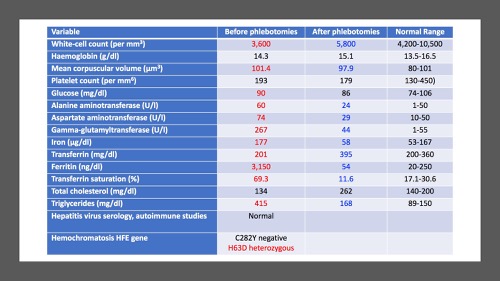
Contributions
Abstract: PB1607
Type: Publication Only
Session title: Iron metabolism, deficiency and overload
Background
Hereditary hemochromatosis (HH) is the most prevalent form of iron overload in Caucasians and comprises a group of disorders that lead to abnormalities in iron homeostasis, increasing intestinal absorption of iron and tissue deposition. If not treated, the accumulated iron can result in tissue damage such as liver cirrhosis, diabetes mellitus, arthropathy, myocardiopathy, endocrine disorders and hepatocarcinoma. Variants C282Y and H63D of the HFE gene (chromosome 6p21.3) are the two polymorphisms most frequently associated with HH. Studies of allele frequencies in northern European populations have reported 10–15% C282Y heterozygotes, 0.25–1.0% C282Y homozygotes, 20–30% H63D heterozygotes and 2% C282Y/H63D compound heterozygotes. The iron-loading risk profile for the possible genotypes is described: C282Y/C282Y >>> C282Y/H63D > C282Y/-, H63D/H63D, H63D/-. Non-C282Y homozygotes with significant iron loading should be investigated for rare iron-loading genotypes. Hypertriglyceridemia (HTG) is a common and important lipid abnormality in Western societies. Approximately 18% of adults have triglycerides over 200 mg/dl, defining HTG. The HFE locus is associated with primary HTG, and in approximately 5% of cases, the HFE genotype could play a role in their pathogenesis. It is supposed thatincreased iron deposits associated with certain HFE genotypes induce an overproduction of liver triglycerides in predisposed individuals. In one study, this synergic effect seems to be especially relevant in C282Y/H63D compound heterozygotes; subjects with this genotype are at low risk of iron overload in the general population but, in the presence of HTG, iron overload penetrance seems to be much higher. On the other hand, phlebotomies significantly decreased triglycerides, especially in subjects with basal HTG.
Aims
To describe the characteristics of a patient with hyperferritinemia, H63D heterozygous and hypertriglyceridemia and the evolution after a phlebotomy regimen.
Methods
Case description.
Results
A 44-year-old male was referred to us because of hyperferritinemia. Body mass index 22.86, No toxic habits, including alcohol consumption. High blood pressure diagnosed at 35. Familiar hypertriglyceridemia. Nephritic colic, renal lithiasis and chronic uric acid nephropathy. He was taking carvedilol, manidipine, doxazosin, ezetimibe+atorvastatin, levetiracetam and omega 3. Abdominal ultrasound showed moderate hepatomegaly of left predominance, with no other abnormalities. Abdominal Angio-TC showed bilateral double renal artery.
Since H63D heterozygous is not supposed to justify the intense hyperferritinemia, rare iron loading genotypes were investigated, showing negative results for SLC40A1, TFR2, HFE2 or HAMP mutations.
The outstanding values of the analysis, and the comparison after the 3 phlebotomies are shown in the table.

Conclusion
H63D heterozygous patients, considered at low risk of iron overload in the general population, can express much higher iron overload penetrance in the presence of hypertriglyceridemia (HTG).
Phlebotomies, even in a low number, led to normalization of the ferritin level, improved hypertriglyceridemia and the hepatic impact of the iron overload (leukopenia, macrocytosis, high liver enzymes) was normalized.
Along with the specific treatment, this case suggests that therapeutic phlebotomy could be a useful therapeutic approach in patients with HTG and iron overload.
Keyword(s): Hemochromatosis, Iron overload
Abstract: PB1607
Type: Publication Only
Session title: Iron metabolism, deficiency and overload
Background
Hereditary hemochromatosis (HH) is the most prevalent form of iron overload in Caucasians and comprises a group of disorders that lead to abnormalities in iron homeostasis, increasing intestinal absorption of iron and tissue deposition. If not treated, the accumulated iron can result in tissue damage such as liver cirrhosis, diabetes mellitus, arthropathy, myocardiopathy, endocrine disorders and hepatocarcinoma. Variants C282Y and H63D of the HFE gene (chromosome 6p21.3) are the two polymorphisms most frequently associated with HH. Studies of allele frequencies in northern European populations have reported 10–15% C282Y heterozygotes, 0.25–1.0% C282Y homozygotes, 20–30% H63D heterozygotes and 2% C282Y/H63D compound heterozygotes. The iron-loading risk profile for the possible genotypes is described: C282Y/C282Y >>> C282Y/H63D > C282Y/-, H63D/H63D, H63D/-. Non-C282Y homozygotes with significant iron loading should be investigated for rare iron-loading genotypes. Hypertriglyceridemia (HTG) is a common and important lipid abnormality in Western societies. Approximately 18% of adults have triglycerides over 200 mg/dl, defining HTG. The HFE locus is associated with primary HTG, and in approximately 5% of cases, the HFE genotype could play a role in their pathogenesis. It is supposed thatincreased iron deposits associated with certain HFE genotypes induce an overproduction of liver triglycerides in predisposed individuals. In one study, this synergic effect seems to be especially relevant in C282Y/H63D compound heterozygotes; subjects with this genotype are at low risk of iron overload in the general population but, in the presence of HTG, iron overload penetrance seems to be much higher. On the other hand, phlebotomies significantly decreased triglycerides, especially in subjects with basal HTG.
Aims
To describe the characteristics of a patient with hyperferritinemia, H63D heterozygous and hypertriglyceridemia and the evolution after a phlebotomy regimen.
Methods
Case description.
Results
A 44-year-old male was referred to us because of hyperferritinemia. Body mass index 22.86, No toxic habits, including alcohol consumption. High blood pressure diagnosed at 35. Familiar hypertriglyceridemia. Nephritic colic, renal lithiasis and chronic uric acid nephropathy. He was taking carvedilol, manidipine, doxazosin, ezetimibe+atorvastatin, levetiracetam and omega 3. Abdominal ultrasound showed moderate hepatomegaly of left predominance, with no other abnormalities. Abdominal Angio-TC showed bilateral double renal artery.
Since H63D heterozygous is not supposed to justify the intense hyperferritinemia, rare iron loading genotypes were investigated, showing negative results for SLC40A1, TFR2, HFE2 or HAMP mutations.
The outstanding values of the analysis, and the comparison after the 3 phlebotomies are shown in the table.

Conclusion
H63D heterozygous patients, considered at low risk of iron overload in the general population, can express much higher iron overload penetrance in the presence of hypertriglyceridemia (HTG).
Phlebotomies, even in a low number, led to normalization of the ferritin level, improved hypertriglyceridemia and the hepatic impact of the iron overload (leukopenia, macrocytosis, high liver enzymes) was normalized.
Along with the specific treatment, this case suggests that therapeutic phlebotomy could be a useful therapeutic approach in patients with HTG and iron overload.
Keyword(s): Hemochromatosis, Iron overload


